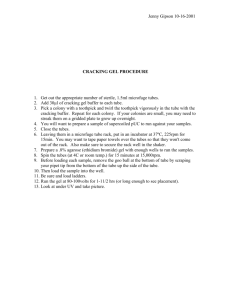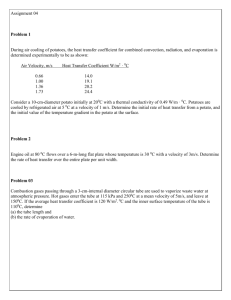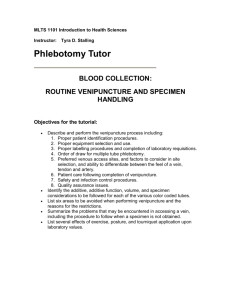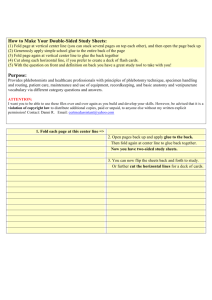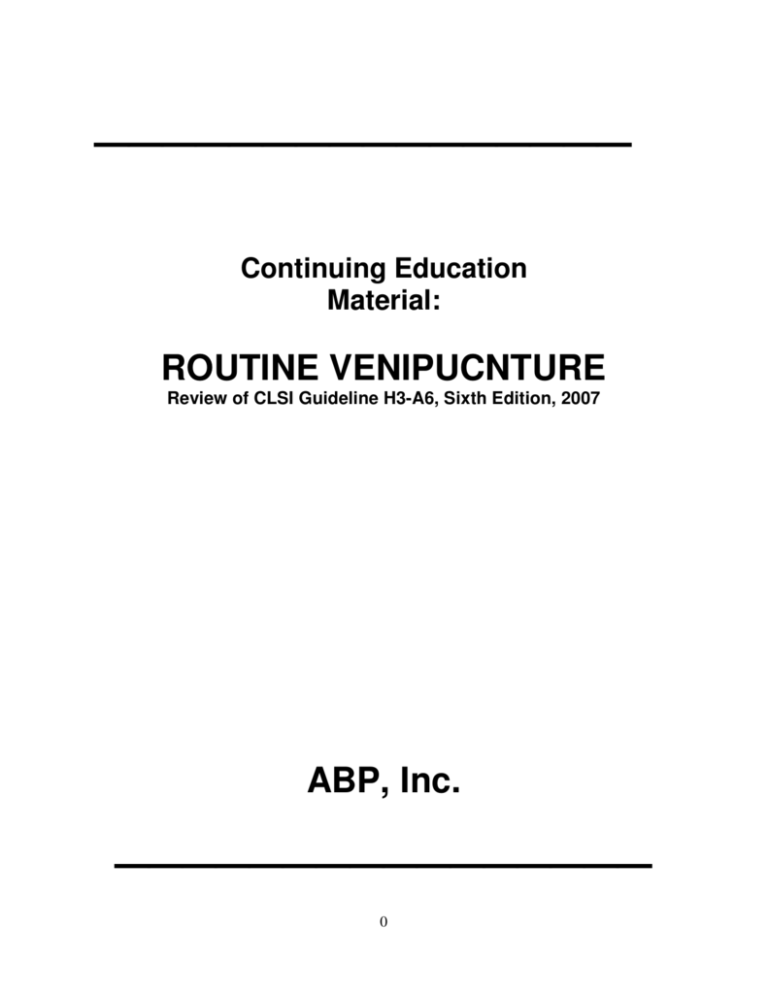
________________
Continuing Education
Material:
ROUTINE VENIPUCNTURE
Review of CLSI Guideline H3-A6, Sixth Edition, 2007
ABP, Inc.
________________
0
ABP CONTINUING EDUCATION MATERIAL
Routine Venipuncture
OBJECTIVES
1.
Outline the steps in routine venipuncture.
2.
Discuss changes in the October 2007 guideline.
TABLE OF CONTENTS
PAGE
Patient Identification
2
Vein Selection & Site Preparation
3
Tube Order of Draw; Coagulation Tests
4
Tube Labeling
5
Miscellaneous
5
Reference
5
This continuing education material, ROUTINE VENIPUNCTURE, will earn the participant 1.0 contact hours. If you have
any questions regarding this information or would like further information on other continuing education opportunities,
please contact:
ABP, Inc.
P.O. Box 127
Granger, IN. 46530
Phone: 574-277-0691 Fax: 574-277-4624
www.abpincorp.com
© Copyright ABP, Inc. 2008
All rights reserved
1
PROCEDURES FOR THE COLLECTION OF DIAGNOSTIC
BLOOD SPECIMENS BY VENIPUNCTURE
CLSI Document H3-A6 (Vol.27 No.26) Sixth Edition, 2007
Significant changes in the 2007 guidebook include: new illustrations of the anatomy of the antecubital
area, instructions on recognizing nerve involvement in the procedure, revised instructions for drawing
blood from patients with vascular access devices, preparing a site for blood culture, and an additional
verification step when labeling tubes.
STEPS IN THE VENIPUNCTURE PROCEDURE
Practice “standard precautions” with each patient – universal precautions and body substance
isolation (BSI).
1. Prepare the accession order.
Make sure that you have the correct equipment needed for the tests that are ordered on the
patient so that the specimens can be processed promptly and accurately.
2. Approach and identify the patient; sanitize hands.
Greet the patient, identify yourself and make sure to obtain proper consent before performing
the venipuncture. Proper patient identification is crucial. Outpatients should be asked to state
their full name, address and birthdate. Inpatients should be asked to state their full name and
that information should be compared to the information on the patient’s identification bracelet.
For inpatients the unique identification number will be the medical records number on the arm
bracelet. Any discrepancy must be resolved before drawing the patient. A nurse or relative
should identify a patient who is unconscious, too young, cognitively impared or does not speak
the language of the phlebotomist. A three part identification system is recommended for use in
identifying unknown emergency room patients. A name and/or unique identification number
should be attached to the patient’s body. Bed labels or arm bracelets taped to the beds are not
an acceptable substitute for one attached to the patient.
Phlebotomists are instructed to “sanitize” their hands in accordance with the CDC Hand
Hygiene Guidelines which allow for the use of alcohol sanitizers between patients.
3. Verify patient’s diet restrictions, if appropriate, and latex sensitivity.
Some tests require the patient to fast and/or eliminate certain foods from the diet prior to a
blood draw. Ask the patient what time and what foods they last had to eat. Time and diet
restrictions vary according to the test. Usual fasting is 8 – 12 hours without anything to eat or
drink except water. Follow the procedure at your facility. Ask the patient about any sensitivity to
latex to avoid sever hypersensitivity and/or anaphylactic reaction to gloves, tourniquets or
bandages.
4. Assemble necessary supplies and put on gloves.
The ETS (evacuated tube system) is the preferred method of blood collection because it allows
the blood to pass directly from the vein into the evacuated tube. It is the safest and most
efficient way to collect blood by venipuncture. A syringe may be used for small or difficult veins
but a syringe safety transfer device must be used to transfer the blood to the blood collection
tube. A winged infusion set may also be used for small or difficult veins but must have a tube
holder or a syringe attached before use. Gloves may be put on at any point in the procedure as
long as they are on before the actual venipuncture occurs.
2
5. Reassure and position the patient.
Never tell the patient that the procedure will not hurt. Follow your facility’s policy regarding
information given to the patient about tests being drawn. The patient always has the right of
refusal. The seated patient should position his arm on the slanted armrest and/or extend the
arm to form as straight line from the shoulder to the wrist. Never draw a standing patient due to
safety issues from fainting. For a lying down patient, a pillow or towel may be used to support
the arm in a similar position. Always have a patient with a prior history of fainting lie down or
recline for the procedure. No food, liquid, gum or thermometer should be in the patient’s
mouth, especially children at the time the specimen is drawn to prevent aspiration and possible
choking.
6. Verify paperwork and the selection of tubes.
The phlebotomist is responsible for verifying that the identification number on the requisition
matches the number on the patient’s bracelet and that the correct tubes are available before
sticking the patient.
7. Apply the tourniquet.
A tourniquet is used to increase intravascular pressure to help with vein palpation. The
tourniquet should be placed 3 – 4 inches above the venipuncture site. Leaving the tourniquet
on for more than one minute can cause hemoconcentration and erroneous results for certain
analytes. If the tourniquet has been on for more than one minute, it should be released and
reapplied after two minutes. A blood pressure cuff may be used as a tourniquet but should not
be inflated to more than 40 mm HG. Veins may become more prominent if the patient makes a
fist. There must be no vigorous pumping which can cause hemolysis or hemoconcentration of
certain analytes in the blood.
8. Select the venipuncture site.
The median cubital vein, located in the middle of the antecubital fossa, and cephalic vein,
located on the thumb side of the antecubital fossa, are the first and second choices because
they are the largest and fullest veins and do not lie near any major arteries or nerves in the
antecubital fossa. The third choice is the basilic vein which lies on the little finger side of the
antecubital fossa and also very close to or on top of the brachial artery. Veins on the back
(dorsal) side of the hand are also acceptable. Veins on the palmer or underside of the wrist are
not acceptable since there are nerves and tendons close to the skin in this area. Alternative
sites such as ankles or arteries are not to be used except with physician permission because
of the potential for medical complications such as phlebitis, thrombosis or tissue necrosis.
Pictures of the antecubital area refer to vein arrangements as the “H-shaped” and “M-shaped”
patterns. The H pattern is named because the cephalic, median and basilica veins are
distributed on the arm in a way that resembles a slanted H. The H pattern is seen in about
70% of the population. In the M pattern, the cephalic, median cephalic, median basilica and
basilica veins resemble the shape of an M. Always consider the median and cephalic veins in
both arms before choosing the basilica vein. Full color pictures are included in the standard.
Use the middle or index finger to palpate for veins. Do not use the thumb since it has a pulse
and may cause confusion.
9. Cleanse the venipuncture site.
Use a gauze pad with 70% isopropyl alcohol or a commercially prepared alcohol prep pad to
cleanse the site. Cleanse the site in a circular motion from the center to the periphery. The site
must be allowed to air dry to prevent the patient having a burning sensation, to prevent
hemolysis of the specimen and to allow for the optimal antiseptic effect of the alcohol.
Proper skin antisepsis for blood culture collection is essential. Traditional skin prep require the
use of 70% isopropyl alcohol or iodine. Tincture of iodine, multiple isopropyl preps,
chlorhexidine gluconate, and povidone iodine/70% ethyl alcohol combinations are equivalent.
3
Follow the manufacturer’s directions when using the commercial prep kit. The use of
chlorhexidine gluconate is not recommended for use on infants less than two months of age.
10. Perform the venipuncture using the correct order of draw.
Inspect the needle to make sure that the seal is intact. Check the tip of the needle for any
hooks, burrs or small particles that could obstruct blood flow, injure the patient or get into the
patient’s blood stream. Make sure that the tubes are not expired or cracked. Hold the patient’s
arm distal to the venipuncture site and pull the skin taut about 1 to 2 inches below the puncture
site by using the thumb to anchor the vein. Do not anchor above the site as this increases the
risk of needle stick accident. Insert the needle, bevel up at a 15 – 30 degree angle between the
needle and the skin. Make sure that the patient’s arm is in a downward position to prevent
reflux or backflow.
The order of draw for blood collection using ETS, syringe or butterfly:
a. Blood culture bottles and/or sterile yellow stopper tubes
b. Coagulation tube (Lt. blue stopper tube w/sodium citrate)
c. Serum tubes with or without clot activator and with or without gel separator (red stopper,
glass or plastic; SST, gold, red-black marbled)
d. Heparin tube with or without gel separator (green or lt. green stopper)
e. EDTA tube (lavender or pearl white stopper)
f. Oxalate/fluoride – Antiglycolytic tube (gray stopper)
Red (glass) non additive tubes may still be drawn after the blood culture or yellow tubes and
before the lt. blue coagulation tubes. It is important to remember to draw the red (plastic) tubes
after the lt. blue coagulation tubes. Gel separator tubes with clot activators are classified as
additive tubes. These tubes should be drawn after the lt. blue stopper tube and before the
other additive tubes – green, lt. green, lavender and gray – to avoid possible test errors due to
cross contamination from tube additives.
Each tube that contains an additive should be mixed immediately after drawing to prevent
microclot formation.
NOTE: If only a coagulation tube is to be drawn for routine testing – PT or APTT – the
first tube drawn may be used for testing. For special coagulation testing - factor assays – the
second or third tube should be used. When use a winged infusion set (butterfly), a discard or
clear tube (non-additive red glass or another coagulation tube) must be drawn first to fill the
dead space in the tubing with blood to prevent under filling of the testing tube and thus
erroneous test results.
If the patient complains of a shooting, electric-like pain, tingling or numbness proximal or distal
to the puncture site, terminate the venipuncture immediately and remove the needle. Make
sure to document according to your facility’s protocol.
11. Release and remove the tourniquet.
The tourniquet should be released as soon as the blood begins to flow.
12. Place gauze, remove needle, activate safety device and dispose of needle assembly as a
unit.
Make sure that the patient’s hand is open to reduce the amount of venous pressure before
removing the needle. Place a gauze pad over the puncture site, taking care not to press down
until the needle has been removed. Cotton balls are not recommended because of the little
hairlike fibers that could clump and interrupt platelet plug formation when removed. Apply
direct pressure to the site without bending the arm. Bending the arm promotes bruising.
4
13. Check for active bleeding and then bandage.
The patient should leave the bandage on for at least 15 minutes. If the patient is not on
anticoagulation therapy and bleeding persists for more than 5 minutes, notify the doctor or
nurse.
14. Label the tubes and record the time of collection.
The label on the tube must contain the following minimum requirements:
• The patient’s first and last name
• A unique identification number
• The date, time and identification of the person collecting the specimen
Labels must be attached to the tube(s) before leaving the patient’s bedside or before the
patient leaves the drawing room.
NEW to this guideline is a recommendation that the labeled tube be compared to the patient’s
identification armband for in patients and to have the outpatient verify the information on the
labeled tube prior to leaving the drawing room.
15. Observe any special handling requirements.
Some specimens require cooling to slow down metabolic processes (lactic acid and ammonia)’
transportation at body temperature of 37̊ to prevent precipitation or agglutination (cold
agglutinin) and/or protection from light to prevent analyte breakdown (bilirubin).
16. Send blood collection tubes to the proper laboratories.
MISCELLANEOUS
• It is not recommended that the venipuncture attempted more than twice. If two people have
each made two attempts, it is time to contact the physician.
• Gel separator tubes must not be used for blood bank specimens.
• Certain tests may require timed collections: glucose, cortisol, hormone levels, coagulation tests
and drug levels.
• Make sure to use a non-alcohol based antiseptic to clean the venipuncture site prior to
collecting a blood alcohol.
• For collecting specimens for trace elements, use a metal-free container.
• Do not draw any blood from an arm that contains a fistula used for dialysis.
• Never draw blood from a site above an IV. Avoid collecting blood from a previous active IV site
for at least 24 to 48 hours after the IV is discontinued to avoid potential test errors.
• The use of ammonia inhalants may be associated with adverse effects (asthma attack) and is
not recommended.
• A mechanism should be in place to monitor the amount of blood drawn from pediatric patients,
geriatric patients and critically ill patients to avoid having phlebotomy induced anemia.
• CLSI guidelines recommend that most routine specimens be processed within 2 hours from
the time of collection.
Reference:
CLSI: Procedures for the Collection of Diagnostic Blood Specimens by Venipuncture;
Approved Standard – Sixth Edition; H3-A6; Volume 27, Number 26; October, 2007.
Complete copies can be obtained from CLSI via:
Fax: 610-688-0700
Phone: 610-688-0100
Email: customerservice@clsi.org
Website:www.clsi.org
Mail: 940 West Valley Road, Ste 1400, Wayne, PA 19087
5
Routine Venipuncture – Self-Assessment Quiz
Please place all answers on the Continuing Education Registration Form.
Mail form to ABP, Inc. to be graded so that you can get your P.A.C.E. certificate.
1. Which of the following is NOT a correct way to identify a patient?
a. Ask, “Are you Mr. Sam Jones?”
b. Compare the number on the requisition with the patient’s armband
c. Ask the patient to state his birthdate.
d. Ask a nurse or relative to identify the patient.
2. Patient identification can be confirmed by using the information taped to the patient’s bed.
a. True
b. False
3. Which of the following statements is NOT correct?
a. Warn the patient before inserting the needle.
b. Ask the patient what time he last had anything to eat or drink except water.
c. Ask a child to drink milk during the procedure.
d. Support the patient’s arm with a towel during the procedure.
4. About 70% of the population has a vein arrangement in the shape of a letter:
a. M
b. H
c. N
d. W
5. Which of the following should NOT be done during venipuncture site preparation?
a. Use 70% isopropyl alcohol for cleansing
b. Use a clean gauze pad to wipe off alcohol prior to inserting the needle.
c. Clean in a circular motion from the inside to outside.
d. Prepare the gloved finger in the same manner before retouching the prepared site.
6. Leave the tourniquet on the arm for longer than one minute can result in:
a. Hemoconcentration
b. Petechiae
c. Bruising
d. Nerve damage
7. The correct order of draw when using the evacuated tube system:
a. SST, Lt. Blue, Green, Lavender, Gray, Red
b. Lt. Blue, Red, SST, Lavender, Green, Gray
c. Lt. Blue, Red, SST, Green, Lavender, Gray
d. Red, Lt. Blue, SST, Lavender, Green, Gray
8. It is important to remove the needle, after activating the safety device, prior to discarding the holder.
a. True
b. False
9. Which of the following statements IS correct about specimen labeling and transport?
a. Label the tubes after leaving the patient’s room.
b. Have an outpatient confirm the information on the labeled tube is correct before leaving.
c. Have the patient label his own tube to make sure the information is correct.
d. A test for a cold agglutinin should be kept chilled until tested.
6
10. Which of the following statements IS correct?
a. An ammonia level must be kept warm after collection and until testing
b. Gel separator tubes may be used for Blood Bank
c. Never collect blood above an IV site.
d. Use Tincture of iodine to prepare the site for a blood alcohol collection.
7




